
What Is Sciatica?
Sciatica is more common than many people realise, affecting not only those with sedentary lifestyles but also physically active individuals. While regular movement is typically beneficial, the sciatic nerve can become irritated by various factors, including poor movement mechanics, muscular imbalances, or spinal misalignment. Certain people may be more susceptible to developing sciatic pain, such as those with a history of back or pelvic injuries, general age-related wear and tear, or those carrying excess body weight. A lack of core stability, prolonged sitting, poor posture during lifting, or underlying health conditions like diabetes can also increase risk. Even lifestyle habits such as smoking, which compromise circulation and tissue healing, may contribute.
Types of Sciatica
Sciatica can be broadly categorised into two primary types:
- Axial—or lumbar radiculopathy, originates from compression or irritation of the spinal nerve roots within the lumbar spine, commonly due to disc herniation, spinal stenosis, or facet joint inflammation.
- Appendicular (Peripheral)— involves entrapment or compression of the sciatic nerve along its path, typically by muscles such as the piriformis or structures in the hip and leg. This form is sometimes referred to as piriformis syndrome or deep gluteal syndrome.
It is not uncommon for individuals to present with a combination of both types, particularly where poor posture, muscular imbalance, and spinal misalignment co-exist.
Axial Sciatica – Originating from the Spine
The Axial type often results from compression of a spinal nerve root by a bulging or herniated disc, degenerative changes in the spine, or instability in the sacroiliac joints. It may also be triggered by poor seated posture, pregnancy-related strain, sacral instability or spinal misalignment.
We can determine the type with a simple test, such as the Straight Leg Raise (SLR):
- Sit on the edge of a chair with a neutral spine.
- Slowly extend the leg on the affected side.
- If sciatic symptoms appear between 30 ° and 70° of elevation, especially when intensified by ankle dorsiflexion, lumbar rounding, or neck flexion, this may indicate nerve root involvement at the spine.

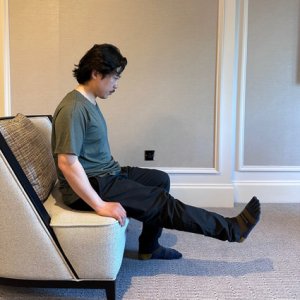
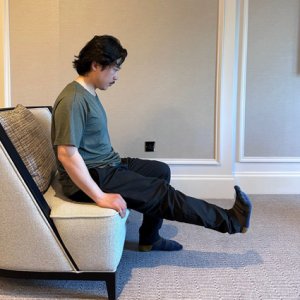
Chiropractic Considerations
Treatment for axial sciatica often includes:
- Chiropractic adjustments to restore spinal alignment
- Gentle mobilisation to reduce nerve root irritation
- Education on maintaining lumbar curvature and avoiding provocative positions (e.g. prolonged flexion)
Movements such as deep forward bends, intense backbends, or unsupported seated positions should be approached with caution, as they can compress the spine and potentially aggravate the sciatic nerve. Maintaining the lower back’s natural curve and modifying these positions accordingly is advisable. Gentle spinal twists may help preserve mobility but should be performed mindfully and without force.
Appendicular Sciatica – Involving the Hips and Legs
When spinal imaging is inconclusive or symptoms persist despite addressing spinal causes, attention should shift to soft tissue structures in the pelvis and lower limb. A frequent cause is the piriformis muscle, which can compress the sciatic nerve if it is tight or inflamed as it exits the pelvis.
In some individuals, the sciatic nerve may even pass through the piriformis, making it more susceptible to entrapment. The sciatic nerve must glide freely within the surrounding tissue. In the average adult, the nerve should be able to stretch up to eight to twelve cm during movement.
Restricted nerve gliding may occur in the:
- Piriformis and deeper hip rotators
- Gluteus maximus
- Hamstrings or adductor magnus in the posterior thigh
Nerve Gliding Test for the Sciatic Nerve
This gentle movement not only assesses nerve tension but also helps to restore normal nerve mobility:
- Lie flat on your back with a neutral lumbar spine
- Bend one knee and place hands behind the thigh
- Slowly extend the leg upwards, pausing if the lower back flattens
- Focus on how the leg feels, not how far it stretches; pain during this action suggests the nerve isn’t gliding smoothly
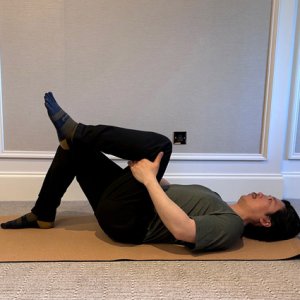
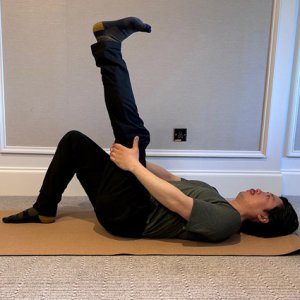
Piriformis Syndrome and Sciatic Pain
Research indicates that up to 70% of non-disc-related sciatica can be attributed to piriformis syndrome or entrapment in the deep gluteal space. Women are significantly more prone to this condition, possibly due to anatomical and biomechanical factors.
Common contributors include:
- Internal hip rotation or knock-knees
- Flat feet causing knee collapse
- Anterior pelvic tilt (often from prolonged sitting or high heel use)
- Habitual sleeping or sitting with crossed legs
- Postural compensations or core instability
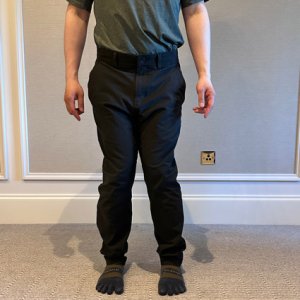

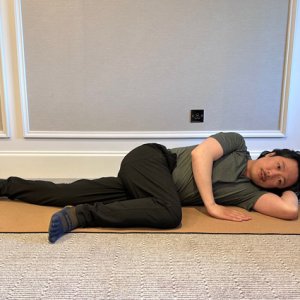
Testing for Piriformis Involvement
There are two clinically useful tests:
Seated Piriformis Stretch Test: Pull the knee toward the opposite shoulder. Increased sciatic pain may suggest piriformis involvement.
FAIR Test (Flexion, Adduction, Internal Rotation): Lying on your side, this position mimics deep gluteal compression.
Why Strengthening Comes Before Stretching
Attempting to stretch a tight, irritated, or weak muscle may trigger a protective contraction, worsening compression on the nerve. The better approach is to build stability before introducing longer holds or deeper stretches.
Trying to stretch a tight or weakened muscle too soon can cause it to contract protectively, worsening pressure on the nerve. The better approach is to strengthen first, then stretch.
Strengthening Example
A safe way to activate the piriformis is to externally rotate the thigh using small, controlled movements. For example, from a hands-and-knees position, press one heel into a wall while rotating the thigh outward. Keep the pelvis stable and the movement small to safely activate the external rotators, including the piriformis.
A Stretching Progression
Once strength and stability are established:
- Lie on your back and cross the affected ankle over the opposite thigh.
- Press the ankle outward gently while drawing the knee in.
- Create light resistance with your hand to engage the hip muscles.
- Avoid any sharp, electric, or stabbing pain; mild tension is acceptable.
Our Holistic Approach to Sciatic Nerve Pain
At our clinic, we take an integrated approach to sciatica, combining services like
- Instrument-assisted chiropractic adjustments to restore spinal mobility and reduce nerve pressure
- Targeted manual therapy to release fascial and muscular tension
- Therapeutic movement and neuromuscular retraining to restore functional alignment
- Education, body awareness and home-based exercises to promote long-term recovery
Final Thoughts
Sciatica is not a one-size-fits-all condition. Whether it stems from the spine or soft tissue structures, lasting relief comes from addressing the root cause, not just the symptoms.
By combining structural care, mindful movement, and personalised guidance, our team helps you move confidently, reduce pain, and prevent recurrence, all without relying solely on medication or invasive interventions.
*Disclaimer: The information provided in this article is for general educational purposes only and is not a substitute for professional medical advice, diagnosis, or treatment. While we aim to share helpful insights and tips, any actions you take based on this content are done at your own risk. Always consult with a qualified healthcare professional before beginning any new health practice or managing an existing condition. Your wellbeing is best supported under personalised, professional guidance.
